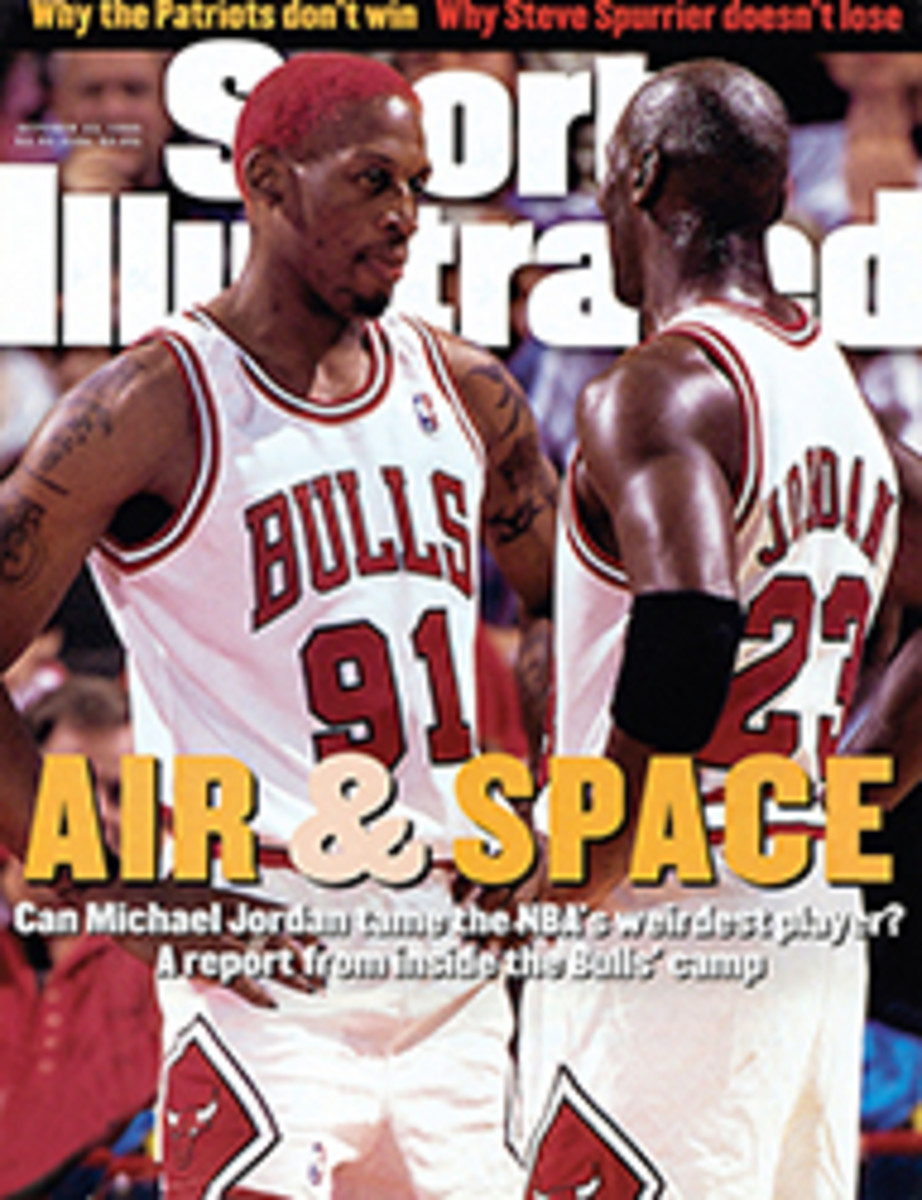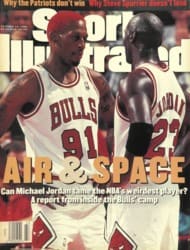
HIGH ON A HOG SACRAMENTO DECIDED TO SPEND ITS TOP PICK ON ARKANSAS FORWARD CORLISS WILLIAMSON-- DESPITE DOUBTERS
Sacramento King vice president of basketball operations Geoff
Petrie's philosophy about the NBA draft can be pared down to a
couple of words: Resist temptation. First, he says, your choice
must be based on the ability of the player, not on the holes in
your roster--even though, Petrie admits with a laugh, "it's human
nature to try to make what you need become the best player." And
you must tune out the chorus of your contemporaries, whose
collective wisdom may differ from your own. "If you're going to
make mistakes," he says, "let them be your own mistakes."
For an illustration of the 47-year-old Petrie's dual resolve,
consider his selection of Arkansas's junior forward Corliss
Williamson with the 13th pick in the draft on June 28. Not
choose for need? Only the Amazing Kreskin had been more
forward-looking than Sacramento last season: As a rookie G.M. in
the '94 draft, Petrie plucked 6'9" forward Brian Grant of Xavier
at No. 8 and 6'8" forward Michael Smith of Providence at No. 35;
they joined frontcourt veterans Walt Williams and Lionel Simmons
on the King roster. What's more, by draft day the Kings had
arranged--but not announced--a deal that would ship point guard
Spud Webb to the Atlanta Hawks for yet another forward, Tyrone
Corbin.
But at crunch time, could Petrie ignore the buzz about
Williamson? Despite an All-America career and two Final Four
appearances, Williamson had as many doubters as believers among
scouts. At 6'7" and 245 pounds, he was short for a power
forward, and he had yet to demonstrate any flair for facing up
to the basket, as any NBA player in the 3 position must. In the
NCAA final against UCLA, 7-foot George Zidek and an aggressive
help defense had limited Williamson to 3-of-16 shooting from the
floor, further fueling concerns about his ability to post up
against larger opponents. One NBA team brought Williamson in for
a workout on the same day it brought in Ohio forward Gary Trent,
who would go 11th (to the Milwaukee Bucks), and the staff found
itself pondering this head scratcher: Was Trent that good or
Williamson that mediocre?
And yet despite both the Kings' need for a playmaker and his
peers' pressure, Petrie made the choice with almost total ease.
"We had pretty much decided before the draft," he says, "that if
Corliss was there, we'd take him."
When the Trail Blazers chose Petrie with their first-ever pick
in 1970, they too were governed by neither need nor league
consensus. Portland's director of scouting, Stu Inman, had
scouted a Princeton game to look at Chris Thomforde, the Tigers'
big man, and was struck instead by their sweet-shooting guard.
Petrie became a co-NBA Rookie of the Year with the Blazers and a
two-time All-Star before he injured his knee in '76. After that
he stayed on with the team in various front-office posts and as
a radio analyst until joining the Kings in June '94.
When Petrie arrived in Sacramento, he immediately instituted a
style of record keeping similar to the Blazers'. Each time a
scout saw a prospect, he would fill out a card; later that data
would be entered into a computer. On one side of the card the
scout would scribble his firsthand observations. On the other he
would rank the player in six major categories: shooting,
passing, rebounding, ball handling, athleticism and mental
toughness. In order to assess each skill, Petrie would ask for
ratings from 1 (the lowest) to 5 (the highest) in a variety of
subcategories. The mental-toughness entry, for instance, would
be the average of numerical grades in toughness,
competitiveness, aggressiveness, court presence and second
effort. The average of the six major categories, carried out to
thousandths of a point, would then constitute the player's final
score.
This grading system gives Petrie a digitized way to rank every
possible draftee. The master list is then Santa-ized: He checks
it twice against the two scouting services he subscribes to and
also has his staff set aside the numbers and stage a mock draft
based more on intuition. Petrie continually has to compensate
for the perspectives of his scouts: player-personnel director
Jerry Reynolds, 51, tends to favor complete players over raw
athletes; scouting director Scotty Stirling, 66, gets excited by
offensive dynamos; assistant coach Wayne Cooper, 39, a former
NBA center, has a sharp eye for big men.
The Kings' scouting brain trust saw Williamson play live 12
times over the course of the 1994-95 college season and at least
25 times over his three-year Arkansas career. Petrie, reading by
the numbers, sums him up: "Great strength. Good speed and the
mentality to run. Probably the best hands in the draft. Average
or a little above in quickness and explosiveness. Fundamentally
sound in every area. A good passer on the block. Hard to get a
handle on defensively because of the way Arkansas played, but
guarded bigger people and did O.K. The big question is, Can he
make the 17-foot jump shot?"
The Kings' numerical scheme rated Williamson the seventh-best
player available; only Joe Smith of Maryland, who would be
picked No. 1 by Golden State, was graded higher in mental
toughness. In the staff's mock drafts Williamson went no lower
than 10th. Petrie figured Williamson would be long gone by the
13th choice, but as the naysayers' voices crescendoed a week
before the draft--and as Trent's stock continued to rise--he began
to think otherwise. In staff meetings the Kings kicked around
the question of whom Williamson played like, and saw
similarities with Adrian Dantley: a small post-up player who
succeeded with strength, determination and fundamental
soundness. Petrie viewed and reviewed the UCLA tape and
concluded that despite his size disadvantage, Williamson had
been able to get space and squeeze off shots against Zidek. He
had simply missed them.
The doubts about Williamson's athleticism didn't faze any of the
King scouts. "We asked ourselves: At the end of the day, how
many players in college basketball have been more dominant than
Corliss?" Reynolds recalls. "And the answer was zero. He's been
the best player on the best team for the last three years."
Nonetheless, Petrie would probably have passed on Williamson
without first having a personal meeting and private workout with
him: He won't draft what he can't see. So Cooper prevailed on
Williamson to come to Sacramento six days before the draft. Once
there, Williamson took a 200-question psychological test (the
upshot: "Special score review indicates no area of concern") and
was interviewed by the staff ("He has a genuine humility about
himself that is somewhat refreshing," Petrie says). The visit
also provided a physical revelation: Williamson's wingspan. It
was every bit as long (85 inches) as the 6'9" Cooper's.
The workout lasted 90 minutes, and it gave coach Garry St. Jean
his first glimpse of the team's possible pick. Williamson showed
how he ran, caught, handled the ball, finished on the break and
shot. Then he and Cooper hooked up one-on-one. "Coop really
tried to push him and dominate him," Petrie says. "But he
couldn't stop Corliss from getting position and from scoring."
"From scouting him, I had seen that Corliss played below the
rim, but on the court I couldn't block his shot," says Cooper,
who had swatted 1,535 shots during his 14-year NBA career. "He's
so strong, and he has such great leverage. His speed is really
deceiving--he just gets to places on the floor."
Like most G.M.'s, Petrie solicits his coaches' input before the
draft, though the ultimate responsibility for the pick lies with
the scouting staff. St. Jean liked Williamson: "He's got things
you don't teach. The strength he has is very special. So is his
feel." Then, on the night of June 28, the first 12 teams passed
him up. "When Corliss was available, that was as close as I've
ever come to kissing Scotty Stirling on the cheek," says
Reynolds. That enthusiasm was tempered slightly three weeks
later, when Williamson underwent surgery for a herniated disk,
an injury that occurred after the draft. None of his physicals
had indicated a problem, and the Kings believe that the surgery
will not set him back significantly.
Reynolds almost puckered up again when Sacramento's first
second-round pick rolled around. Tyus Edney, UCLA's 5'10",
152-pound blur of a point guard, was still on the board at No.
47. Not only would he felicitously fit into the playmaking void
created by the Webb trade, but he was also the Kings'
32nd-highest-rated prospect. Then, with the 51st choice, Petrie
took a far-flung flyer: 6'8" Dejan Bodiroga of Bosnia, a
22-year-old perimeter player who is under contract to Stefanel
Milano of Italy for the upcoming season. While only Petrie and
his European scout had seen Bodiroga play live, Petrie did show
tape of him to his staff.
Their advice? Says Petrie, "They told me, 'You're on your own
with this one.'"
COLOR PHOTO: JONATHAN DANIEL From Day One, King brain trusters (from left) St. Jean, Petrie and Reynolds had eyes for Williamson (34). [Garry St. Jean, Geoff Petrie, and Jerry Reynolds] COLOR PHOTO: DAVID E. KLUTHO [See caption above--Corliss Williamson]
The Kings rated Williamson the seventh-best player available;
only Joe Smith was graded higher in mental toughness.

